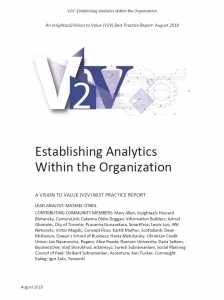Vision to Value (V2V), the Canadian professional community focused on accelerating adoption and use of analytics in Canada, has released its fourth best practice report.
Establishing Analytics Within the Organization reflects the collected insights of 18 Canadian thought leaders, including practitioners and managers with major financial services, telecommunications and government organizations, consultants from both global firms and boutiques specializing in delivering analytics projects, academics from leading Canadian universities, and subject matter experts from V2V c community founders InsightaaS and Information Builders. The report – the fourth and final document in the “analytics in a business context” series – covers issues that are critical to Canadian firms looking to build a foundation for an evidence-based culture.
About the report
 Establishing Analytics Within the Organization has five major sections. The first, “factors in establishing demand for analytics within the organization,” examines issues that need to be addressed in the course of establishing analytics as an organizational force. These include culture, demonstration of successes associated with early initiatives, process evolution, information utility and a section highlighting potential barriers to creating demand for analytics within the organization.
Establishing Analytics Within the Organization has five major sections. The first, “factors in establishing demand for analytics within the organization,” examines issues that need to be addressed in the course of establishing analytics as an organizational force. These include culture, demonstration of successes associated with early initiatives, process evolution, information utility and a section highlighting potential barriers to creating demand for analytics within the organization.
The second and third report chapters deal with internal success factors. In the second chapter, the report conveys the opinions of the contributors on the best way for analytics to take root within the organization: is demand for data most likely to grow as a result of top-down mandates, or should interest be expected to grow organically – “department-out” – with one group’s success spawning another’s interest? There are success path examples for both, and for approaches that combine top-down stimulus and department-out achievement and recognition. The group members observed that the maturity of the organization and its industry (with respect to use of data to inform decisions) will have an impact on the success of the different tactics. In the third, the report captures insights into the key inputs required to establish analytics within the organization: skills and training, policies, data quality, the relevance of the outputs to employees, and solution licensing/licensing terms, which can affect the pace and depth of analytics tool adoption.
The fourth chapter shifts to a scenario-centred approach: how does analytics evolve within the organization? Here, the working group looked at three points in the process. The first is the initial adoption stage: the adoption path, divided into top-down and department-out perspectives. The second looks at the growth factors that lead to increased adoption and corporate reliance on analytics, including success indicators. The third point is the “evolved organization” – what is the organizational template for a data-driven organization? This chapter is followed by a concluding section entitled “The path forward,” which provides concise guidance from the working group members.
Launch event
Establishing analytics within the organization was launched at a meetup hosted by V2V community sponsor Information Builders. Featuring a case presentation, an interactive panel discussion with leading Canadian analytics professionals drawn from different industry segments and extensive peer/professional networking, the event drew a ‘standing-room-only’ audience to Information Builders’ Canadian headquarters in downtown Toronto.
The session began with a presentation by two senior Ontario Ministry of Labour analytics professionals, Michael Ray, director, data management branch, and Kavita Khera, senior manager-analytics. Ray kicked off the session by highlighting the importance of understanding the performance of key programs: “how are we doing in terms of impact? Are we seeing the results that we are expecting – and if not, why not?” And from a forward-looking perspective, “where should we invest next?”
Ray then dug down into some of the structural considerations to answering questions of these types. Prior to the initiative that his team has launched within the Ministry, there was little coherence across functions – limited inter-group collaboration, and a lack of technology platform and data standards. Analysts were deluged with requests, but lacked the capacity (both tools and data) to meet this demand, leading to a regular triage of requests, with responses offered only the most urgent issues.

To address the Ministry’s needs, Ray proposed a single, centralized, stand-alone data unit, and helped Ministry management to understand the benefit by articulating the ways that the approach would address current information pain points. He also structured a performance review program; this was important in securing buy-in from key stakeholders.
Kavita Khera then picked up the narrative, talking about the operational management of the centralized unit. She stressed the importance of taking a staged approach that enabled the Ministry to build capacity while managing expectations. Key stages in the process included developing skills profiles and specifications for roles in the new unit, investment in analytics technology, and training and development on the analytics platform.

After this case presentation, a team of expert practitioners – Kartik Mathur from Scotiabank, Jan Naranowicz from Rogers, Hania Metulynsky from Ukrainian Credit Union, Prasanna Gunasekara of SmartProz (and formerly of the City of Brampton) and Joe Walsh from Information Builders – engaged in a spirited discussion that raised and analyzed several important organizational issues.
The discussion followed the structure of the report, starting with the key factors in establishing demand. Jan Naranowicz stated that within Rogers, the key has been the analytics unit’s ability to

provide useful data that can improve company results
and which is tailored to the user’s role, making information relevant to both overall objectives and specific requirements. Hania Metulynsky urged attendees to start with culture – to build a shared vision and set of values around data, with an understanding that roles (data scientist, data analyst and data engineer) will evolve as the organization becomes more mature in its understanding and use of data.


Kartik Mathur elucidated an elegant five-level vision of how analytics becomes integrated with operations. Leadership, he believes, comes from the C-level – “now a Chief Data Officer, a key role that designs strategy for data and builds support” within the organization. Other important roles include data scientists who are responsible for modelling, data analysts who derive insights from corporate information, data engineers who create the infrastructure needed to support the analysts and data scientists, and a data governance function that includes both “an IT and a business custodian – data stewards – who develop contractual relationships with the various business units on data ownership” and other core data issues.

Prasanna Gunasekara focused on where the impetus for analytics adoption and use originates, noting that “in practice, it’s ideally top down” from a policy perspective, but that actual projects often bubble up from users or business units with specific requirements. Joe Walsh expanded on this point, stressing the need for senior management to lead by example by using data insights in their own measurement, goal setting and performance measurement, creating impetus for data use throughout the organization.
Obtaining the report
Establishing Analytics Within the Organization is available at no charge to professionals who would like to understand how to build an evidence-based culture within their organizations. Please follow this link to reach the registration form.








